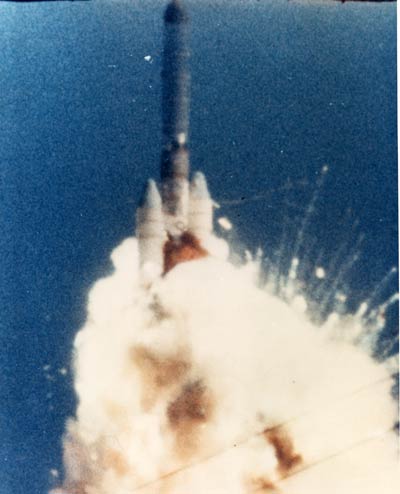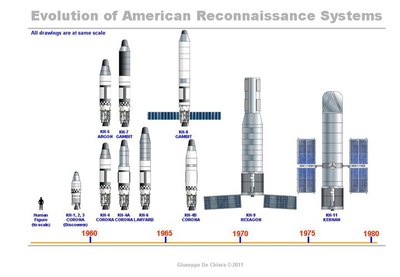The flight of the Big Bird (part 4)The origins, development, and operations of the KH-9 HEXAGON reconnaissance satelliteby Dwayne A. Day
|
| The HEXAGON materials remain classified, but a tremendous amount of CORONA material has been declassified, providing an indication of how the HEXAGON imagery was exploited. |
Like switching from binoculars to a sniper scope, the National Reconnaissance Office alternated the HEXAGON launches with launches of the more powerful KH-8 GAMBIT satellite. After the January 1972 launch of the second KH-9, the NRO launched KH-8s in March and May. The third KH-9 launch in July 1972 was followed by a KH-8 in September, another KH-9 in October, and a KH-8 in December.
After seven launches of KH-8 and KH-9s in 1972, the number of launches slowly fell as the lifetimes of both satellites increased—six KH-8 and 9 launches in 1973 (three of each), five in 1974, four in 1975, and three in 1976 and 1977. Depending upon the weather, a single KH-9 mission could usually photograph the entire Soviet Union, allowing photo-interpreters back in Washington, DC, to detect any significant changes since the last mission. Anything new, or important—say a missile silo, or a guided missile cruiser under construction at a shipyard—could be tagged for the upcoming GAMBIT mission to photograph at high resolution.
In December 1976 the two workhorse film-return satellites were joined by a new companion, the KH-11 KENNAN. The KENNAN could take a picture and send it back to the ground within minutes, whereas the GAMBIT and HEXAGON took days. It is unclear how this altered the strategy for photographing the Soviet Union, but after the first KH-11 launch, KH-8 GAMBIT launches appear to have started to taper off. There was one KH-8 launch in 1977, but none in 1978, one in 1979, none in 1980, and one in 1981. The KH-11 appears to have essentially replaced the KH-8 GAMBIT in the high-resolution spotting role, although its resolution was reportedly not as good as the film-based satellite. The KH-11 could not provide the immense ground coverage of the KH-9, however.
In January 1982 the NRO launched a special KH-8, a version known as HIGHER BOY that had been sitting in storage for over a decade, ever since it was modified when NRO program managers became concerned that the first KH-9 launch would be delayed. They ordered that a KH-8 be converted to fly at a higher altitude to produce pictures of broader swaths of the Earth, fulfilling the area search function that CORONA had performed since 1960. But when HEXAGON made its debut in 1971, HIGHER BOY was put in storage until, for reasons unknown, it was eventually pulled out of storage, refurbished, and flown. It apparently suffered some problems and the film may not have been successfully recovered. This probably had no effect upon the overall reconnaissance program, because the HEXAGON was returning truly massive amounts of material.
Each HEXAGON film return capsule—there were four, plus a smaller one containing film from the mapping camera—contained thousands of feet of film approximately six inches (15 centimeters) wide. The small width of the film covered 80 miles (130 kilometers) approximately north-south. As a HEXAGON flew over the Soviet Union its cameras swept back and forth over the territory below, doing what intelligence officials referred to as “mowing the lawn.”
The film was recovered in mid-air over the northern Pacific Ocean, flown back to Hawaii, loaded on an Air Force jet, and flown to California. From there it was flown to an Eastman Kodak processing facility in Rochester, New York. Kodak developed the film, made duplicate positives and negatives, and the positives were then immediately flown to Washington, DC. At Building 213 at the Navy Yard, in the seedier part of the nation’s capital, photo-interpreters at the National Photographic Interpretation Center, or NPIC, scrolled the film out on their light tables and immediately began looking at top priority targets. During the time since the last mission the CIA had collected other information, such as seismic indications of underground nuclear tests at the Soviet nuclear testing ground, and the interpreters would look at imagery of that and other flagged areas to see if they could spot changes.
| Although additional payloads on the spacecraft itself remain unknown, many KH-9 spacecraft deployed smaller subsatellites. |
Other key targets that were among the first to be checked were rocket test facilities such as the sprawling base at Tyura-Tam (now known as Baikonur), airfields like Ramenskoye where new aircraft—including the Buran space shuttle—were tested, and port facilities. After checking these locations and firing off intelligence cables with quick updates about new developments, the photo-interpreters would settle down a bit and start slogging through the imagery take, counting aircraft and their type at airfields, looking for changes and new construction at ICBM silos, and counting tanks and military equipment at army bases.
The HEXAGON materials remain classified, but a tremendous amount of CORONA material has been declassified, providing an indication of how the HEXAGON imagery was exploited. Each CORONA mission, particularly the latter ones with two film-return vehicles and a large film load, ultimately resulted in the production of imagery interpretation reports equivalent to several phone books. Most of this information has been declassified for over a decade now and anybody can go to the National Archives facility in College Park, Maryland and access it. The imagery interpretation reports from a single CORONA mission add up to several thousand pages with short one-to-three-sentence descriptions of thousands of targets within the Soviet Union. HEXAGON’s take—four reentry vehicles, a lot more film, and a broader coverage area—dwarfs the CORONA material. It is unclear how the interpreters kept up, but they were never short of work.
Tossing ferrets
Because the KH-9 was so massive, it provided other capabilities that the KH-11 could not match. The Satellite Control Section (SCS), a can-shaped propulsion module at the rear of the spacecraft, included two segmented rings with twelve compartments each. Some of the compartments carried mission support equipment, but at least a few of them were apparently available to carry other equipment. It has been rumored that the KH-9 itself carried signals intelligence equipment. The satellites may have also carried “agent communications” equipment that would allow a spy in a foreign country to transmit a message up to the satellite for later retransmission when the spacecraft flew over a secure ground station.
Although additional payloads on the spacecraft itself remain unknown, many KH-9 spacecraft deployed smaller subsatellites. This was a technique first developed in the early 1960s with the Program 11, or P-11, satellites. The P-11s were relatively small, rectangular boxes that were ejected from the aft rack of some GAMBIT missions. The P-11s were manufactured by Lockheed and each had flexible antennas that unfurled from their sides when they started spinning and gathered up electronic signals from Soviet radars that ran through a couple of electronic boxes on the satellite and then recorded on Leach tape recorders. The P-11s were replaced by other satellites using the same standard spacecraft bus and continued flying into the 1970s. Many HEXAGON missions launched these subsatellites as well. They were mounted near the front of the vehicle, along the boom that held the film return vehicles, under the payload shroud.
In addition to the signals intelligence satellites, three HEXAGON missions also launched Small Secondary Satellites, also known as “S-3.” The S-3 satellites were similar in appearance to the ferret satellites—rectangular boxes sloped on one side so that they could fit underneath the curved Titan payload shroud. But the satellites, built by Boeing, were specifically designed to host a large number of small experiments. The S-3s were spin-stabilized, with an integral solid-rocket motor for injecting them into a different orbital plane from the KH-9 that carried them into orbit.
The three S-3 satellites had a total of 34 individual payload sensors for measuring density and composition of the atmosphere. The goal of the experiments was to better understand why satellite orbits decayed. The satellites lasted about six months each in orbit.
 A Titan 34D launch vehicle carrying the final KH-9 satellite explodes shortly after liftoff in April 1986. (credit: USAF) |
The Big Bird goes boom
By the early 1980s the retirement of the KH-9 program was in sight. The KH-9 offered incredible capability, but the cost was quite high, particularly the recovery forces needed to retrieve the film, and the satellites returned imagery days or even weeks after the photos were taken. Although it is possible that the NRO considered adapting the KH-9 to fly aboard the space shuttle, this seems unlikely, and the HEXAGON was probably scheduled for retirement along with the Titan rocket.
The lifetime of the spacecraft was also getting longer. Missions in 1977, 1978, and 1979 all lasted about six months in orbit. Mission 1216, launched in June 1980, lasted 261 days in orbit. No KH-9 was launched in 1981, but mission 1217, launched in May 1982, lasted 208 days in orbit and was followed by mission 1218 in June 1983, which lasted a record 275 days. For unknown reasons, mission 1219, launched in June 1984, operated only 115 days in orbit, the shortest lifetime in a decade and a possible indication of a problem with the spacecraft. This was also the first launch atop a Titan 34D rocket, a more powerful version than the Titan IIID that had lofted all previous HEXAGON spacecraft.
In August 1985 a KH-11 did not reach orbit when its Titan 34D failed during launch. A number of large intelligence satellites, including the KH-9, depended upon the Titan 34D, and its problems grounded them.
| The investigation continued on so that the Titan could be placed back into service. But that made no difference for the HEXAGON program. There were no more KH-9s left. |
By April 1986 the Air Force program managers believed they had solved the problems with the Titan 34D and the rocket was now ready for the next flight, the launch of the last KH-9 HEXAGON on mission 1220. There were more people at the launch site than usual both because of the previous failure and because of the KH-9’s final flight. They sucked in their breaths as the powerful rocket roared to life and rose above its launch pad, and then gasped as it erupted into an ugly smoky fireball, raining debris down on the pad and surrounding area and starting small brushfires. (See “Death of a monster”, The Space Review, December 15, 2008.)
Investigators began combing through the debris and reviewing telemetry tapes. Somebody found shells nearby and some in the Air Force became concerned that a person with a rifle had shot the big bird out of the sky. But the telemetry tapes contained the details, indicating that what the investigators called “anomalous conditions” began at 8.38 seconds after launch and the vehicle’s computers commanded an engine shutdown at 15.53 seconds and command destruct at 16.38 seconds.
The investigation revealed that rubber insulation that surrounded propellant in the solid rocket motors had come loose near a joint between two segments of one booster, allowing hot combustion gases and heat transfer to burn through the steel rocket case. The rocket blew up.
The investigation continued on so that the Titan could be placed back into service. But that made no difference for the HEXAGON program. There were no more KH-9s left. The debris from the last one was packaged into steel drums, hauled off to the Nevada desert, and buried.
